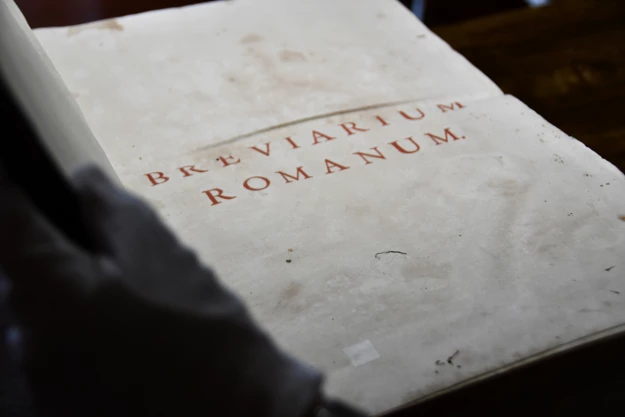Joanina Digital Project: a Roman breviary from 1697
The technical processing of the heritage holdings of the Joanina Library continues, highlighting items that enrich the UC database and add knowledge for the scholarly and university community. In this second example, we focus on the «Breviarium romanum ex decreto Sacrosancti Concilii Tridentini restitutum S. Pii V Pont. max. jussu editum, Clementis VIII et Urbani VIII».
The Breviarium romanum ex decreto Sacrosancti Concilii Tridentini restitutum S. Pii V Pont. max. jussu editum, Clementis VIII et Urbani VIII, from the Plantin Press (1697 edition), forms part of the dissemination of the Roman Breviary according to post-Tridentine directives, with the particularity of being one of the many editions issued by the Plantin Press, which held the exclusive licence to print Missals, Breviaries, and Offices in Antwerp.
The breviary—a liturgical book intended for the Liturgy of the Hours—is printed in red and black, with text in two columns and engravings of the liturgical feasts inserted throughout. It is worth noting the dynamic composition that distinguishes this type of publication (the addition of multiple separate offices), according to the specific liturgical rites of each religious community, thereby giving each copy its own identity.
The composition of the present copy focuses on two main titles: the Breviarium Romanum of 1697 and the Officia propria Sanctorum trium ordinum S.P.N. Francisci of 1700, from the same press. To the first,11 separate Offices are appended; to the second, 20 Offices and Supplements, mostly relating to the Order of Friars Minor, all with printing licences (imprimaturs) dated between 1703 and 1739. In this second part, we also note the presence of an imperfect leaflet consisting of a single surviving leaf, relating to the Proprium Sanctorum Hispanorum, also found in similar breviaries. The holdings of the Joanina Library include another edition of the Breviarium Romanum, from the same press (1614), which contains a complete version of this divine office.
The National Library of Portugal holds a copy with a very similar composition to the one presented here. The Public Library of Évora also holds the two mentioned titles, although with no indication that they are bound in the same volume.
The significance of this copy is also due to its distinctive materiality. The binding has wooden boards covered in leather, with decorative motifs outlined by fillets in three concentric rectangles, tooled in gilt; there are ten bosses (five on each board) and traces of two metal clasps/fastenings; the spine has a thickness of 18 centimetres and the edges are coloured red.
With no traces of provenance, we report that the copy has undergone multiple repairs and is in poor condition due to heavy handling, compromising the integrity of part of the text. Given the poor state of conservation (loose/trimmed and torn leaves), the Joanina Digital project provides for the restoration of this and other items in the BGUC workshop, so as to ensure their preservation and a legible reading in the images to be made available.





